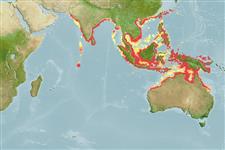>
Clupeiformes (Herrings) >
Dorosomatidae (Gizzard shads and sardinellas)
Etymology: Escualosa: Latin, squaleus, squalidus = with rough skin + Latin, alausa = a fish cited by Ausonius and Latin, halec = pickle, dealing with the Greek word hals = salt; it is also the old Saxon name for shad = "alli" ; 1591 (Ref. 45335).
More on author: Valenciennes.
Environment: milieu / climate zone / depth range / distribution range
Ecologie
marien; zoet water; brak water; amfidroom (Ref. 51243); diepte 0 - 50 m (Ref. 188). Tropical; 27°N - 22°S, 64°E - 151°E (Ref. 188)
Indo-West Pacific: northern Indian Ocean (Karachi eastward to Rangoon) to Thailand, Indonesia (Java Sea), the Philippines, Papua New Guinea, and Australia.
Lengte bij maturiteit / Grootte / Gewicht / Leeftijd
Maturity: Lm ?, range 7 - ? cm
Max length : 10.0 cm SL mannelijk / geslacht onbekend; (Ref. 188); common length : 8.0 cm SL mannelijk / geslacht onbekend; (Ref. 188); max. gerapporteerde leeftijd: 1.00 Jaren (Ref. 43081)
Dorsale stekels (totaal): 0; Dorsale zachte stralen (totaal): 13-21; Anale stekels 0; Anale zachte stralen: 14 - 19. Belly strongly keeled. The almost rectangular second supra-maxilla and the bright silver stripe along the flank distinguish it from juveniles of Sardinella, Amblygaster and Herklotsichthys. Resembles some pellonulines with a silver stripe, but they lack a first supra-maxilla. Distinguished from E. elongata of the Gulf of Thailand but its deeper body and broader silver stripe.
Forms schools in shallow waters, the juveniles apparently entering the lower parts of rivers, but returning later to the sea. Feeds on both zooplankton (copepods, crab zoea, larvae of bivalves and fish eggs) and phytoplankton. Breeds from October to February (mainly November to January) off western coast of India, usually in relatively shallow inshore waters. Marketed fresh and dried-salted.
Whitehead, P.J.P., 1985. FAO Species Catalogue. Vol. 7. Clupeoid fishes of the world (suborder Clupeoidei). An annotated and illustrated catalogue of the herrings, sardines, pilchards, sprats, shads, anchovies and wolf-herrings. FAO Fish. Synop. 125(7/1):1-303. Rome: FAO. (Ref. 188)
Status op de Rode Lijst van het IUCN (Ref. 130435)
Gevaar voor de mens
Harmless
Gebruik door de mens
Visserij: commercieel
Meer informatie
ReferentiesAquacultuurAquacultuurprofielKweeklijnenGeneticaElectrophoresesErfelijkheidZiektesVerwerkingNutrientsMassaconversie
Tools
Speciale rapporten
Download XML
Internetbronnen
Estimates based on models
Preferred temperature (Ref.
123201): 26.7 - 29.1, mean 28.4 °C (based on 1160 cells).
Fylogenetische diversiteitsindex (Ref.
82804): PD
50 = 0.7500 [Uniqueness, from 0.5 = low to 2.0 = high].
Bayesian length-weight: a=0.00776 (0.00514 - 0.01173), b=3.05 (2.93 - 3.17), in cm total length, based on LWR estimates for this species & (Sub)family-body (Ref.
93245).
Trofisch niveau (Ref.
69278): 3.2 ±0.1 se; based on diet studies.
Generation time: 0.6 ( na - na) years. Estimated as median ln(3)/K based on 2
growth studies.
Weerstandsvermogen (Ref.
120179): Hoog, minimale populatieverdubbelingstijd minder dan 15 maanden (tmax=1).
Fishing Vulnerability (Ref.
59153): Low vulnerability (10 of 100).
Nutrients (Ref.
124155): Calcium = 479 [229, 1,053] mg/100g; Iron = 3.32 [1.94, 5.79] mg/100g; Protein = 18.8 [17.7, 19.9] %; Omega3 = 0.471 [0.232, 0.956] g/100g; Selenium = 49 [22, 104] μg/100g; VitaminA = 23.9 [9.6, 55.9] μg/100g; Zinc = 2.6 [1.7, 4.0] mg/100g (wet weight);
